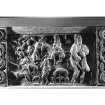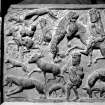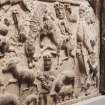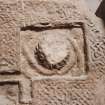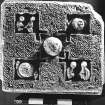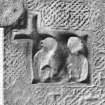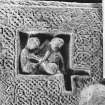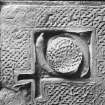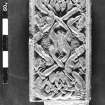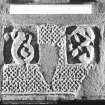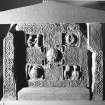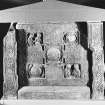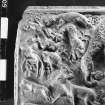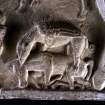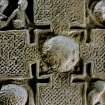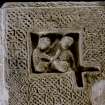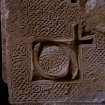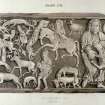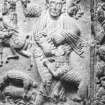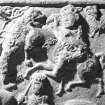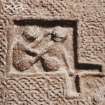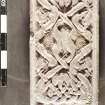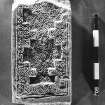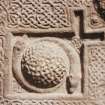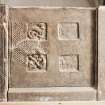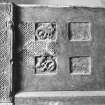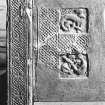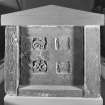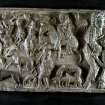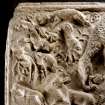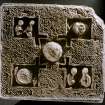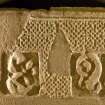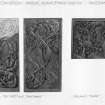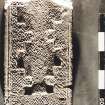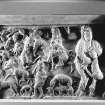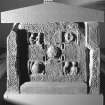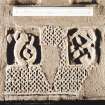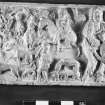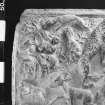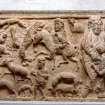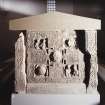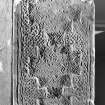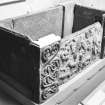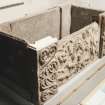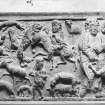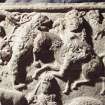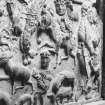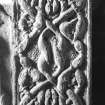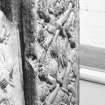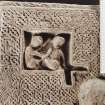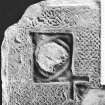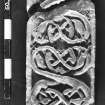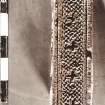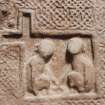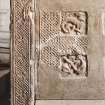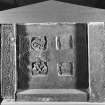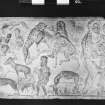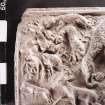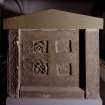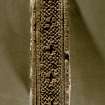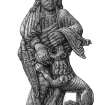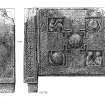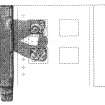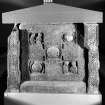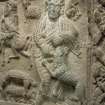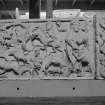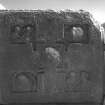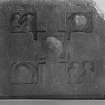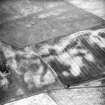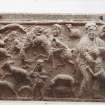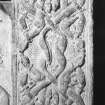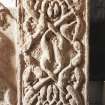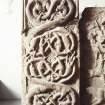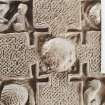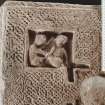St Andrews Cathedral, Museum, St Andrews Sarcophagus
Composite Slab Shrine (Early Medieval), Sarcophagus (Early Medieval)
Site Name St Andrews Cathedral, Museum, St Andrews Sarcophagus
Classification Composite Slab Shrine (Early Medieval), Sarcophagus (Early Medieval)
Alternative Name(s) St Andrews 1; 1a; 1b; 1c; 1d; 1e
Canmore ID 319320
Site Number NO51NW 23.01
NGR NO 5142 1662
Datum OSGB36 - NGR
Permalink http://canmore.org.uk/site/319320
First 100 images shown. See the Collections panel (below) for a link to all digital images.
- Council Fife
- Parish St Andrews And St Leonards
- Former Region Fife
- Former District North East Fife
- Former County Fife
Reference (1903)
St Andrews Nos. 1, 1a, 1b, 1c, 1d, and 1E, are portions of an altar-tomb of sandstone in the shape of a rectangular box, constructed of four upright slabs (one at each corner), grooved vertically to receive the four inner slabs which form the panelled sides of the box. The upright corner-posts are 2 feet 4 inches high by from 1 foot 1 inch to 1 foot 2 inches wide and by from 4 1/2 to 5 1/2 inches thick; the middle front panel is 3 feet 6 inches long between the uprights by 2 feet 2 inches high by 3 1/2 inches thick. The complete tomb measures 5 feet 9 inches long by 2 feet 11 inches wide by 2 feet 4 icnhes high. One of the corner-posts, one of the long panels, and one of the short panels (with the exception of a small fragment) are missing. The existing portions are numbered as follows:-
No.1 - The long panel forming the middle of the front.
No.1A - The short panel forming the middle of the left end.
No.1B. - The upright corner-post on the right of the long panel of the front.
No.1C.- The upright corner-post on the left of the long panel of the front.
No.1D.- The upright corner-post on the left of the short panel of the left end.
No.1E.-A fragment of one of the missing panels.
J R Allen and J Anderson 1903
Field Visit (16 June 1926)
Portions of a sarcophagus or altar-tomb in the shape of a rectangular box constructed of eight stone slabs, three of which, however, are missing. The tomb measures 5 feet 9 inches long by 2 feet 11 inches wide by 2 feet 4 inches high. Each long side has been composed of three slabs, that in the middle, which is the largest, fitting into a groove cut in each of the other two. The single slab at either end is similarly fitted into a groove on the inner face of the adjoining side-slabs. On the one side which is complete (Fig. 390 ) the large central slab is filled mainly with hunting scenes, the upper left-hand corner having a background of foliage after a fashion familiar in such designs in. the East. In the upper centre is a man on horseback having a hawk on his wrist and being attacked by a lion. Below is a man on foot, armed with spear and shield. To the right is the figure of David (Early Christian Monts., p. 351), the full height of ·the panel, wearing a pallium above a tunic and tearing open the jaws of a lion. Above one shoulder is a horned sheep, and above the other is a sitting beast from which the head is broken away. The slabs to right and left are decorated with animal forms intertwined in the most complicated manner. One end is also complete (Fig. 388). Here the slab has an equal-armed cross with stepped intersections, the cross and margins being decorated with a continuous plait-work. In the centre of the cross-head is a boss of spiral work, and at diagonally opposite corners are other bosses of interlaced work developed from the tails of serpents. Each of the remaining corners is occupied by two seated figures in different attitudes. The ends of the adjoining side-slabs are treated as flanking panels and are covered with interlaced work. One of these is the narrow end of the only remaining portion of the incomplete side of the tomb. On the front it shows a diagonal key-pattern sunk within borders of interlaced work and plait-work. A fragment of the other end slab was found near St. Rule's Church and is preserved in one of the cases. It indicates a design similar to that on the end which is complete; two of the small panels are visible, in the lower of which are two seated figures interlocked, while in the upper one is an animal developed into interlaced work. At this end the flanking panel, formed of the one side-slab which is still in situ, is ornamented with a vertical row of six small sunk crosses on a background of ten-cord plait.
RCAHMS 1933, visited June 1926
Publication Account (1987)
St Andrews Cathedral was an Augustinian foundation, the original community being brought to the Church of St Rule, St Andrews, about 1127. The building of the present cathedral began in 1160 on a site adjoining St Rule's Church. The cathedral church was set on a grand scale with an internal east·west dimension of over 109 m. This makes it one of the longest churches ever built in Britain and by far the greatest church in Scotland. Unfortunately very little now survives apart from the ruined gables and parts of the south wall. The monastic buildings to the south of the church are even more ruinous apart from a remarkably well preserved precinct wall; it encloses about 12.14 hectares and is 1.6 km long, 6.1 m high and 0.8 m thick, fortified by a series of attached towers, some round and others rectangular.
After the foundation of the cathedral and priory in 1160, building work followed the usual sequence, building in height from the east end towards the west front The choir was completed prior to 1238 when Bishop Malvoisine was buried there. The great west front was destroyed in a storm and rebuilt between 1273 and 1279. Work may have been delayed by the Wars of Independence but the 'new kyrk cathedralle' was consecrated by Bishop Lamberton in 1318 in the presence of King Robert Bruce.
The second half of the 14th century saw the greater part of the cathedral destroyed by fire. The timber work of the choir and transepts had to be renewed as did a number of piers in the nave and transepts. The urgent work of consolidation took seven years to complete and the total damage was not remedied until 1440. From then until the Reformation the church required only minor repairs. After the Reformation, when it suffered the burning of images and mass-books and the breaking of altars, it was allowed to fall into decay. In 1826 the Barons of the Exchequer took possession of the ruins and in 1946 it was given to the State.
A museum was established in an isolated building commonly called the Prior's House. Included amongst the sculpture housed in the museum is an important example of late 8th or early 9th century work known as the St Andrews Sarcophagus, although its function is more likely to have been that of a shrine or reliquary rather than a normal coffin. It is a stone box,composed of slabs slotted into corner-posts, and its reconstructed gabled roof is conjectural. This is the earliest sculpture surviving from St Andrews, despite its formidable ecclesiastical history; perhaps all trace of an earlier Dark Age church settlement was destroyed at the Reformation.
The Sarcophagus consisted originally of four thin sandstone panels fitting into the grooved sides of four substantial corner-posts, but only two panels and three posts have survived. Much of the carving has been carried out in remarkably high relief, and the main long panel represents a major work of David iconography: the human figures depict scenes from the biblical life of David, and their treatment shows strong Mediterranean influence. The large figure represents David rending the jaws of the lion, the figure on horseback wields a sword in his right hand and a falcon on his left and is under attack from a lion, while the standing figure has shield and sword. All three figures are dressed in elaborately draped clothing quite unlike the normal Pictish tunics. Exotic elements include the griffon devouring a mule to the left of the large figure of David and the pairs of monkeys depicted on the end-panel. The sculptor's mastery of interlace ranges from the animal interlace on the corner posts to the intricate patterning of the cross on the end-panel.
This skill in carving interlace can also be seen on the great cross-shaft (no. 14), where all four sides of the shaft are covered in beautifully executed woven ribbons, and on the shaft of another free-standing cross (no. 19), both of which may have been created in the 9th century. They reflect, together with other sculptural fragments in the museum, the importance of St Andrews in the early medieval period.
St Rule's Church stands to the south-east of the cathedral. The narrow proportions of the church, its solid walls and minimal windows, suggest similarities to Northumbrian building practice of pre-Norman Conquest date, although it was probably erected towards the end of the 11th century. The tall square tower with round headed two-light windows also belongs to the late Anglo-Saxon or early Anglo-Norman period. There are similarities between this tower and the tower at Restenneth Priory (no. 65). The church towers at Dunning (NO 019144), Markinch (NO 297019) and Muthill (NN 867170) have similar two-light windows.
The foundations of the 12th century Culdee church of St Mary of the Rock (NO 515166) can be seen to the east of the cathedral and St Rule's Church, between the perimeter wall and the harbour.
Information from ‘Exploring Scotland’s Heritage: Fife and Tayside’, (1987).
Photographic Record (October 1996)
A detailed photographic record of the sarcophagus was made by RCAHMS in October 1996.










































































































